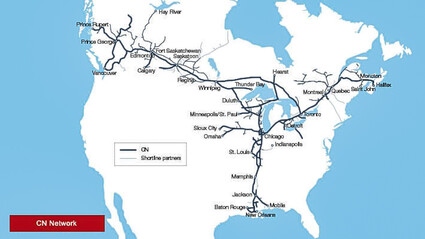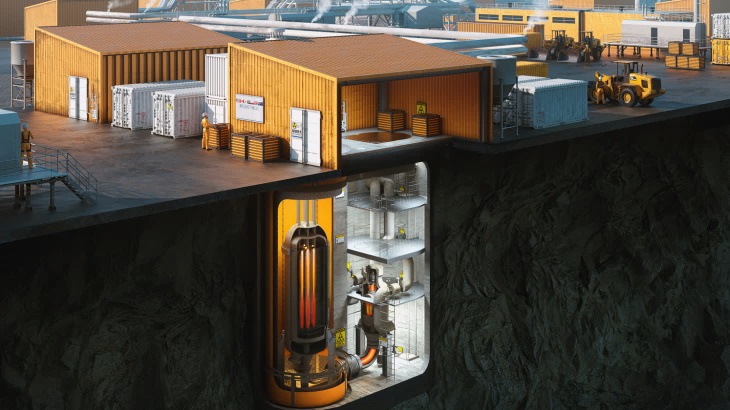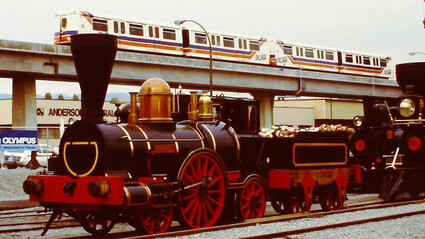Opening up access to inhospitable regions, allowing transport in great quantities, distances; Canada owes itself to trains North of 60 Mining News - May 5, 2023
While the journey west during the frontier days often paints a picture of strife and hardship, not every tale was filled with sorrow and loss. Although covered wagons were definitely a thing, the journey toward greener pastures became much less arduous as steamboats and stagecoaches followed routes mapped by the earliest pioneers. However, it was the coming of the railroad that increased the speed of the trek, and its effectiveness in travel persists even today.
For much of the time during the late American frontier, brave hopefuls made the journey to the West; while this period lasted from the early 1600s to just after the turn of the 20th century, toward the end, early renditions of modern amenities began to appear.
Along with the general assumption of unruly, unkempt, and uncivilized lifestyles, travel by horse and wagon seems to have been permanently etched into the minds of everyone for this period. Yet, most may not know that the first railroad built in North America dates back to 1830.
While the allure of owning land drew the most migrants to the coast, it was ultimately the belief in manifest destiny – the God-given right for westward expansion – and economic promise that convinced settlers to seek their fortunes. Pair that with the first rumblings of gold and silver being discovered mid-century, and the inevitability of colonization was most assuredly guaranteed.
However, while the dramatic flair of the Oregon Trail further instilled a bitter and knife's-edge trip rife with disease and storms, by 1850, railways were far more common and thus, travel was not nearly as restricted.
Nevertheless, this story is about travel across the North and Canada's 100-year passage from a single railroad to its own transcontinental success and eventual dominance in North American train systems.
Canada's first railroad
Although the task of surveying and the eventual construction of the first American railroad – a whole 14 miles (22.5 kilometers) of track from Frederick, Maryland, to Point of Rocks, Maryland – it was shortly after that Canada followed suit with the construction of the Champlain and St. Lawrence Railroad (C&SL) which connected La Prairie, Quebec, with St. Johns (now Saint-Jean), Quebec, in 1836.
This 16-mile (26 kilometers) line was built as a four-foot 8 1/2 standard gauge railway, with rails consisting of 6-inch pine logs, joined by iron splice plates and bolts laid across wood crossties. The pine rails were then protected by iron straps spiked to the upper surface. While rudimentary, these rails remained unchanged until the 1850s, being replaced with entirely iron rails.
Financed by Montreal entrepreneur and brewery owner John Molson, C&SL was intended to become a portage to connect the St. Lawrence River valley with Lake Champlain, which ultimately cut travel time between Montreal and New York.
Like British North America's first railway, its first locomotive arrived in Montreal that same year. Named the Dorchester, it was constructed by Robert Stephenson, son of George Stephenson, who is historically renowned as the "Father of Railways."
Nicknamed the "Kitten" by those who noticed its uneven "skittish" gait – a result of its short wheelbase, which came from its wood-burning 0-4-0 design. This was the 127th locomotive built by Stephenson. Trial runs took place at night to avoid frightening the public, and with its state-of-the-art engine, this train, no larger than a school bus, topped at a whopping 30 miles (48 kilometers) per hour.
The C&SL opened to great fanfare on July 21, 1836. Over 300 people crowded the passenger cars in La Prairie station for its first run. Unable to handle such a load, the two first-class coaches carrying loftier guests were uncoupled and hauled by the locomotive while the remaining cars were pulled by horse.
With the wonder of locomotion now revealed to the Canadian public, a different fever overtook the northernmost North American country, and the hope of traveling the breadth of Canada was suddenly a reality.
Trains made northern mining possible
With the second-ever railway built in Canada after C&SL being used for coal transportation from Nova Scotia, it was quickly understood the benefit of hauling natural resources by train.
However, due to the very nature and size of Canada, to this day, it is still difficult to access and transport natural resources, especially from mining, a mainstay of the northern nation's economy.
Approximately 75% of the world's mining companies are headquartered in Canada, with Toronto being the financial center for the mining industry, and Vancouver being considered the mining capital of the world.
Mining is so prevalent in Canada's economy that entire towns and transportation systems have been constructed solely for easy access to those resources.
A prime example is the Pine Point zinc mine in Canada's Northwest Territories.
After the presence of lead south of the Great Slave Lake was discovered in 1898 by prospectors on their way from Edmonton to the gold fields of the Klondike, the issue of how to claim this orebody immediately became evident.
Although the land saw some initial work, it would not be until the 1950s that the Consolidated Mining and Smelting Company or Cominco (now Teck Resources), principally controlled by the Canadian Pacific Railway Company, would begin an intensive program of drilling that proved the presence of a substantial body of lead-zinc ore.
Declining zinc-lead ore in southern British Columbia, and the prospect of having to import ore from abroad for its smelter, compelled Cominco to send a proposal to Parliament seeking financing and construction.
Aimed at facilitating shipment of lead-zinc ore from the Pine Point Mine, the company would operate from 1965 until it shuttered operations in 1988.
Located on the south shore of the Great Slave Lake between Hay River to the west and Fort Resolution to the east, this massive lead-zinc deposit lies within the boundaries of Northwest Territories.
In its time, the mine produced and shipped roughly 14 billion pounds of zinc and 4 billion lb of lead from around 64 million metric tons of ore averaging about 10% zinc equivalent.
Initially called the Great Slave Railway, which connects Grimshaw, Alberta, to the mine, at the time, it was made part of the then-Crown corporation CN Rail. Later, the line was sold by CN Rail to become a short line named the Mackenzie Northern Railway but was later reacquired by CN in 2006. Today it is officially known as the Meander Subdivision.
Extending 602 miles (969 kilometers), the Meander Subdivision is now the northernmost trackage of the contiguous North American railway network.
With operations being picked back up again at Pine Point by now-owner Osisko Metals, a preliminary assessment of the value of the mine suggests it still hosts 15.8 million metric tons of indicated resource averaging 4.17% zinc and 1.53% lead, plus 47.2 million metric tons of inferred resource averaging 4.43% zinc and 1.68% lead.
This translates to a present mine that could produce an average of 329 million lb of zinc and 141 million lb of lead annually over a 12-year mine life. While these numbers don't compare to 1960s-era mining, it is still a substantial resource – which is made infinitely more accessible due to the existing railway.
Canada was built on the back of a train
The Canadian railway system saw several expansion booms throughout the last century. Much like the gradual growth of civilization from homesteaders that settled in rural areas, which would eventually grow into towns and then possibly cities; an initially disconnected rail system was gradually integrated with other systems that eventually spiderwebbed into the state it is today. However, sometimes explosive growth isn't always a good thing.
With the hunger whetted, heavy expansion would happen due to the Railway Guarantee Act of 1849, which supplied bond returns on all railways over 75 miles (121 kilometers). This led to the rapid expansion of the railway system in Canada; however, it also led to excessive growth as many unnecessary lines were built just to claim the government payment.
Many Canadian railways were gradually brought together under larger conglomerates, but by the end of the First World War, the sudden and decisive financial collapse of these corporations created a severe threat to Canadian infrastructure and economy.
This ultimately proved disastrous for government finances as well, all but bankrupting the Canadas through subsidies.
Around the same time, the largest train company, the Grand Trunk Railway, was vastly mired in debt with the wonton construction of railways and the purchasing of smaller entities. With Grand Trunk defaulting on its debt and the Canadian government unable to pay the promised subsidies, a bargain was struck, 'we'll take your railway; you don't have to pay.'
This essentially squared each other away from having to pay the other.
In addition to setting the standard for the first nationalized railway, the Grand Trunk was also one of the main factors that pushed British North America towards Confederation. Hence, without trains, the present Dominion of Canada would perhaps be an entirely different government today.
This nationalization and consolidation process produced the Canadian National Railways. The American Great Depression, however, led to a decline in rail traffic, and the sudden reversal of this during World War II left railways with overtaxed, aging, and poorly maintained infrastructure.

Canadian National Railway Company
As the largest train company in Canada, the Canadian National Railway Company was privatized in 1995. Becoming a publicly traded company allowed it to expand outside Canada's borders, purchasing Illinois Central Railroad and Wisconsin Central Transportation, among others.
Despite this, toward the end of the 1950s, railways began to transition toward diesel trains. Nevertheless, ridership on passenger trains declined postwar, leading railways to pursue their abandonment. Yet the necessity for transporting goods never went away.
Even now, after nearly 200 years, the infrastructure is still needed throughout the North. Much of Canada's northern territories aren't viable due to a lack of infrastructure. The same can be said for Alaska. Yet perhaps due to the present energy transition, mining may become something to ally with rather than resist as it is the only thing that will provide the necessary quantities of materials needed for clean energy technologies.
One thing is certain, though – Canada would not be anything close to what it is today without railways.
CN Railway recently celebrated its 100th anniversary in 2019. To commemorate its long history, the company put together a digital book of its journey. You can read it here.
https://plawiuk.blogspot.com/2022/10/books-agony-and-ecstasy-of-vancouver.html
.jpg?ext=.jpg) The signing of agreements between the IAEA and CAEA (Image: CAEA)
The signing of agreements between the IAEA and CAEA (Image: CAEA) The Micro Modular Reactor design (Image: USNC)
The Micro Modular Reactor design (Image: USNC).jpg?ext=.jpg) PCAT was loaded onto a truck for its journey from Idaho to Pennsylvania (Image: INL)
PCAT was loaded onto a truck for its journey from Idaho to Pennsylvania (Image: INL)-730x730.jpg) The non-nuclear prototype has been installed into a two-story frame at CEI's facility (Image: INL)
The non-nuclear prototype has been installed into a two-story frame at CEI's facility (Image: INL).jpg?ext=.jpg) The general opinion (Image: OSGE)
The general opinion (Image: OSGE) A robotics specialist at work (Image: Jacobs)
A robotics specialist at work (Image: Jacobs).jpg?ext=.jpg) Darlington 3 reactor face (Image: OPG)
Darlington 3 reactor face (Image: OPG).jpg?ext=.jpg) FEAS researchers Jennifer McKellar, Kirk Atkinson and Xianke Lin, pictured in the university's Energy Research Centre (Image: Ontario Tech University)
FEAS researchers Jennifer McKellar, Kirk Atkinson and Xianke Lin, pictured in the university's Energy Research Centre (Image: Ontario Tech University)
